We are off from the Grassland’s flat fields and heading to our final stop on this Biome tour and boy is it ever wet and salty here!
The Marine Biome contains all water bodies not included in the Freshwater Biome. These bodies of water have a salt concentration higher than 1%. As you probably guessed, this is a lot of water! In fact, it covers about ¾ of the Earth’s surface. Although all of this water is salty there are still tons of differences between them. Some Marine areas can be shallow like the coral reefs, deep like the oceans, or link freshwater to the ocean, which are called estuaries.
The Marine Biome is vital to the health of species in many other biomes – evaporation of its waters produces rain and much of the carbon dioxide in the atmosphere is absorbed by this biome’s marine algae.
RED
Fire Shrimp or Blood Shrimp (Lysmata debelius)
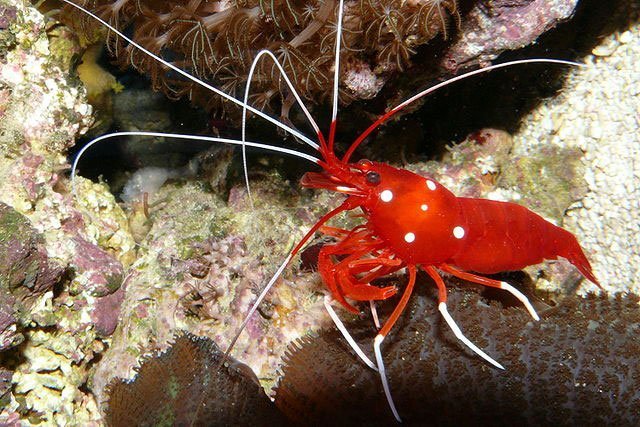
Details: What colour comes to mind with the words “fire” and “blood”? RED! Oh boy is this shrimp red! White is the only other colour found on its body, which is located on four pairs of polka dots, its legs and antennae.
My Hood: This shrimp is found in the Indo-Pacific Oceans from Japan to the Maldives and the Society Islands. You can find it at depths of 20m and below, but look carefully because it might be hiding.
How I fit in: A fire shrimp forms bonds with members of its species. They and can even tell these individuals apart from other Fire Shrimps. When they need to, they will defend their territory but generally they aren’t very aggressive. In fact, they aren’t just friendly to small fish, they are actually important for their health. The shrimp eats the parasites and dead tissue from the fish. The fish is cleaned and the fire shrimp has a tasty snack!
Helmut Debelius and Hans A. Baensch, Marine Atlas: The Joint Aquarium Care of Invertebrates and Tropical Marine Fishes. Brighton: Steven Simpson Books, 1994: Page 474
John H. Tullock, Clownfishes and Sea Anemones. Hauppauge, NY: Barron’s Educational Series, 1998: Page 59
John H. Tullock, Bring Me Home! Saltwater Aquariums Make a Great Hobby. Hoboken, NJ: Wiley Publishing Inc., 2006: Page 123
J Emmett Duffy and Martin Thiel, Evolutionary Ecology of Social and Sexual Systems: Crustaceans as Model Orangisms. New York: Oxford University Press, Inc., 2007: Page 133
ORANGE
Ocellaris Clownfish (Amphiprion ocellaris)
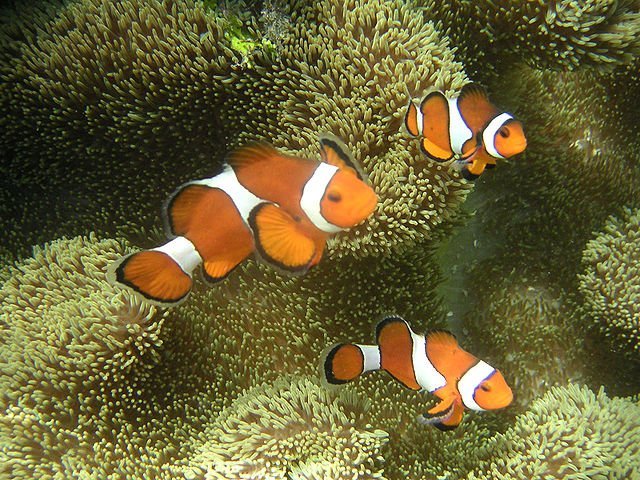
Details: Ocellaris Clownfish grow up to 110mm long and have three white bands that wrap around their body. They usually range in colour from orange to reddish-brown, but some, found in Northern Australia, are black. Due to their similar appearances, Ocellaris is often confused with the True Clownfish (Amphiprion percula) but there are some differences. The Ocellaris has thinner black lines, more dorsal spines, and bigger eyes than their cousins.
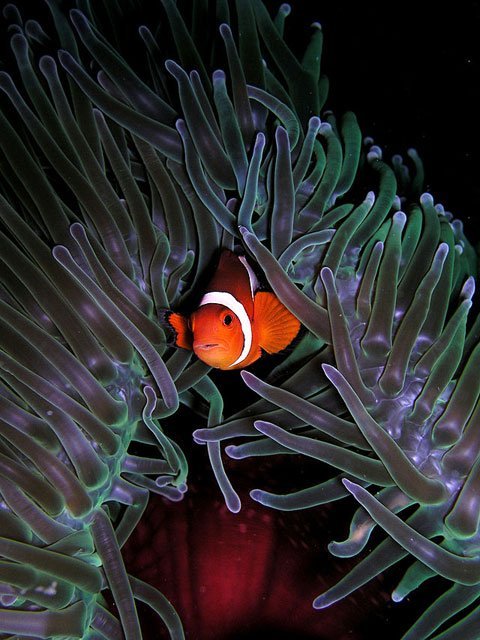
My Hood: In the coral reefs and lagoons of Asia and Australia. They are found close to three species of anemones: Heteractis magnifica, Stichodactyla gigantean, and Stichodactyla mertensii.
How I fit in: Ocellaris choose to make their homes in anemones and develop immunity to its stings by rubbing their bellies and fins on the anemone’s tentacles. These clownfish are in a symbiotic relationship with the anemones, which means that both species benefit. Ocellaris receive shelter and protection for their nests, while anemones thrive when they have a host fish, like Ocellaris.
http://www.arkive.org/common-clownfish/amphiprion-ocellaris/
More information about Ocellaris and Percula!
YELLOW
Leafy Seadragon or Glauert’s seadragon (Phycodurus eques)
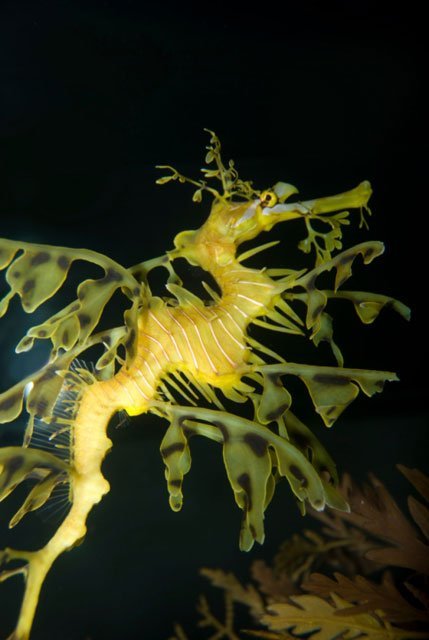
Details: Leafy Seadragons have long toothless snouts, hard boney plates surrounding their bodies, and usually measure 30-35cm. Their colours vary with location, diet, and age. Those living in shallow water are yellow-brown to green, while those found in deep water are dark brown to red.
My Hood: They live in the clear waters off Australia’s southern coast in areas with low light and lots of vegetation.
How I fit in: With leafy appendages and slow movements, this seadragon blends perfectly into seaweed beds, allowing it to hunt undetected. Since it doesn’t have a stomach or teeth, it is constantly searching for food. When prey is spotted, these seadragons suck them up, eating it whole by expanding its lower jaw. If camouflage fails and predators spot them, they can use their sharp spines as a defense.
http://animaldiversity.ummz.umich.edu/site/accounts/information/Phycodurus_eques.html
http://www.aquariumofpacific.org/onlinelearningcenter/full_description/leafy_seadragon/
GREEN
Sailors’ Eyeballs or Bubble Algae (Valonia ventricosa)
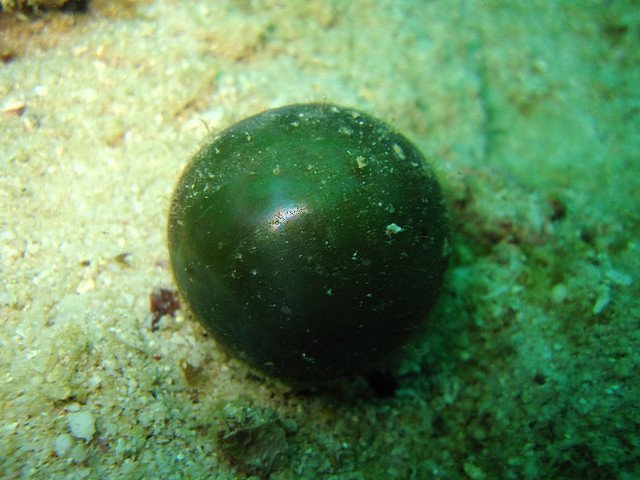
Details: Sailors’ Eyeballs are round, dark green and one of the largest single celled creatures in the world. Their size varies with location: from the size of a grape in Florida to a small hen’s egg in the West Indies.
My Hood: They can be found in most shallow salt waters around the world. They grow on rocks and ledges, but will often break loose and wash up on beaches.
How I fit in: It may be hard to see them at first, they can be very small and dormant, but once they start growing, they can pop up all over the place. Better think twice before attempting to remove them because they can burst very easily, shooting out thousands of spores through the water and spreading more algae. This can be bad for the ecosystems because these algae can outgrow the native organisms, like coral, and cause them to die.
http://netclub.athiel.com/algae/algae.html
http://biogeodb.stri.si.edu/bocas_database/search/species/6654
Charles James Hillson, Seaweeds: A Color-Coded, Illustrated Guide to Common Marine Plants of the East Coast of the United States. Pennsylvania: The Pennsylvania State University, 1977: Page 62
Douglas G. Capone, Nitrogen in the Marine Environment. Burlington MA: Elsevier Inc., 2008: Click here!
BLUE
Regal Tang or Palette Surgeonfish (Paracanthurus hepatus)
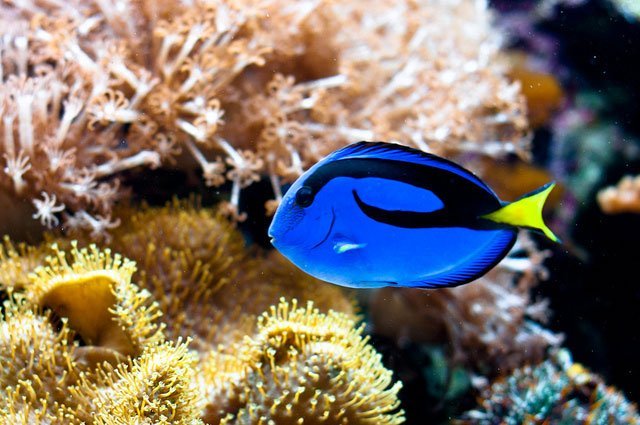
Details: Regal Tangs can measure 12-38cm but usually they are 25-31cm. They have vibrant blue bodies accented with dark stripes and yellow tails.
My Hood: They are native to reefs with swift currents in the Indian and Pacific oceans, but have been introduced elsewhere.
How I fit in: When they are threatened, Regal Tangs hide between the branches of Cauliflower Corals. If they are spotted, they lie on their side hoping that predators will mistake them for a dead fish. If this still doesn’t work, they have sharp toxic spines that they can use against their predators. It also helps that Regal Tangs like to hang out as a group so when one is under attack they will all come together for protection. Regal Tangs also provide a service for other fish. When they are stressed, the blue on their body becomes darker, informing everyone around them that danger is near!
http://www.eol.org/pages/222042
PURPLE
California Purple Sea Urchin (Strongylocentrotus purpuratus)
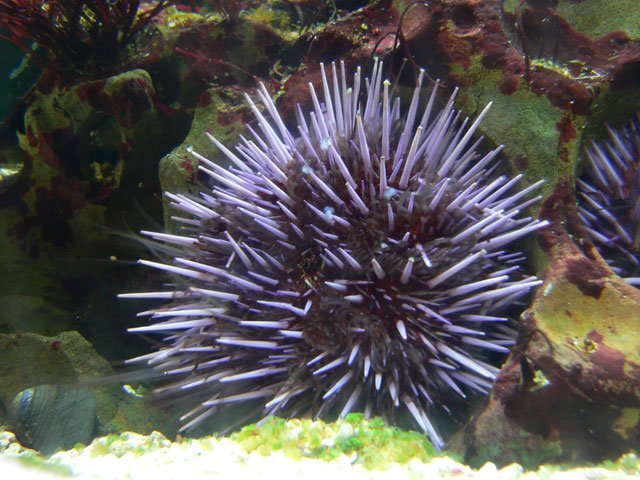
Details: Purple Sea Urchins are green when they are young and turn purple with age. They have a round inner shell covered with pincers, large spines and tube feet. Their feet not only allow them to move, they also use them for breathing because urchins don’t have gills or lungs. Adults can grow up to 7cm across.
My Hood: These urchins live close to the shore from Vancouver Island to Isla Cedra Baja California.
How I fit in: Purple sea urchins protect themselves from predators by hiding under shells, rocks and algae. If they are spotted, they can defend themselves with pincers or by make an escape to a safer place. When it is time for the Urchin to eat, they capture food by creating water currents using their tiny hairs. Too many urchins in one spot can be detrimental to an area’s vegetation – they can destroy entire kelp forests. However, their presence isn’t necessarily a bad thing. When water is polluted, they show signs quickly, allowing people to clean it up and prevent other species from getting sick.
http://www.montereybayaquarium.org/animals/AnimalDetails.aspx?id=781774
To find out more about the marine biome check out these links:
http://www.ucmp.berkeley.edu/exhibits/biomes/marine.php
http://www.bioexpedition.com/ocean-biome.html
Learn exactly what a biome is and find out what you can do to help conserve them: http://www.earthrangers.com/wildwire/hot/introducing-biomes/
Missed one of the articles or just want to explore them again? Check out the types of biomes for the full list.
With this, our exploration into the world of biomes and its colourful species has come to an end. But fear not! If you found this topic interesting, check out Earth Rangers’ Daily Dose of Biodiversity Basics. There are enough biodiversity facts to satisfy even the hungriest of environmental minds!


clown fish is nemo
regal tang is dory
I wish I were a fish
ARE CALIFORNIA PURPLE SEA URCHIN LIVING OR NON-LIVING ORGANISM.THE BLOOD SHRIMP IS SOOOOOO IMPRESSIVE.
so cool
I like the sea
THEY LOOK So cool
Social studies this is science science and social studies are so cool they Rock.
I I lovedory the
I like salamanders and fish but all of them are cute